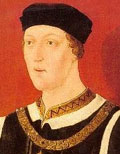| Henry was the son of King Henry V and Catherine of Valois, daughter of Charles VI, king of France. When he was only eight months old, his father suddenly died in France (31 Aug 1422) and Henry became King of England and Heir of France according to the Treaty of Trois (1420). The death of Henry V became known at London and Westminster only on 28 Sep 1422. Before Parliament was convened on 9 Nov 1422, Henry VI also succeeded to the throne of France when his maternal grandfather died on 21 Oct 1422. Parliament rejected the claim of the king's uncle, Duke of Gloucester, to act as regent for his nephew according to the last will of Henry V. Instead, cooperative rule was introduced (5 Dec 1422), with the king's Council as principal organ of government and two protectors — the dukes of Gloucester and Bedford. The latter safeguarded the English interests in France and was entitled to supersede Gloucester's authority whenever he visited England. In 1425 retainers of Gloucester clashed in London with those of Henry Beaufort, half-brother of Henry IV, and in 1426 Bedford had to return to prevent further violence. The king's minority formally ended with his coronation in the age of seven (6 Nov 1429), but the king's Council retained its authority. As the English expansion in France reached its apogee, Bedford took young Henry to France, leaving Gloucester as lieutenant (23 Apr 1430 - 29 Jan 1432). Henry was crowned as king of France in the Cathedral of Notre-Dame de Paris (16 Dec 1431). Henry started to exercise his royal authority as early as 1436, but he showed little personal initiative in government. Abandoned by its Burgundian allies (1435), England suffered continuing defeats on the continent. From 1443 to 1450 the government was dominated by William de la Pole, Earl of Suffolk, who was held responsible for the defeats and murdered in 1450. The losses of Maine (1448), Normandy (1450) and Gascony (1450-1453) marked the end of the Hundred Years' War. The rivalry of the factions headed by the dukes of Somerset and York boiled over into open warfare. In July 1453 the king's health collapsed and he suffered the bouts of insanity. Queen Margaret claimed the regency, but a powerful baronial clique, backed by the Earl of Warwick, had Richard Duke of York appointed protector (3 Apr 1454). The recovery of the king's health at Christmas 1454 undermined York's position, who confronted Somerset and defeated him in the Battle of St Albans (22 May 1455), which opened the Wars of the Roses (1455-1485). When another bout of madness struck Henry, York was again made protector (19 Nov 1455), but was dismissed on 25 Feb 1456. The Queen's utter hostility to York and determination to ensure the succession of her son Prince Edward led to the attainder of Yorkist lords in the Coventry Parliament of November 1459 triggering further hostilities. After the Battle of Northampton (10 Jul 1460), Henry VI was captured by the Yorkists and York presented to Parliament his claim to the kingship (16 Oct 1460). Parliament recognized him as Henry VI's heir (31 Oct 1460) and proclaimed this decision on 8 Nov 1460. The last months of Henry's reign ended with a series of battles. The control of London became a focal point for the conflict, and on 30 Dec 1460 York was confronted by a royal army in Battle of Wakefield. He, his eldest son Rutland, and the Earl of Salisbury were slain, but on 2 Feb 1461 another son of the late York, the Earl of March, defeated the Lancastrians in the Battle of Mortimer's Cross. Although Queen Margaret regained control of the King after the second Battle of St Albans (17 Feb 1461), London denied access to the Queen and the Earl of March was installed as King Edward IV on 4 Mar 1461. On Palm Sunday (29 Mar 1461) Edward's army faced the Lancastrians at Towton and won a complete victory. Henry VI, Margaret and Prince Edward flee to Scotland. The king lived in Scotland and in northern England, until he was betrayed and captured near Clitheroe in Lancashire (July 1465) and confined in the Tower of London. When the powerful Warwick, exiled to France, reconciled with Queen Margaret, he invaded England in September 1470 and forced Edward IV to flee abroad. On 3 Oct 1470 Henry was visited in the Tower by bishops and lords and soon released (5 Oct 1470). The "crown-wearing" ceremony in St Paul's Cathedral (13 Oct 1470) was held to confirm Henry's "readeption", but the king was merely a puppet in the hands of Warwick. The restoration of Henry came to an end when Edward IV and his army entered London (11 Apr 1471). The same day Henry was handed to Edward. He died in the dead of night 21/22 May 1471, either of grief, as officially put out, or murdered on Edward's orders, as most sources believe. [2; 3; 4; 5] |

